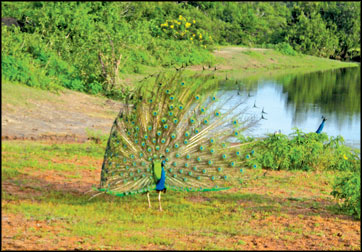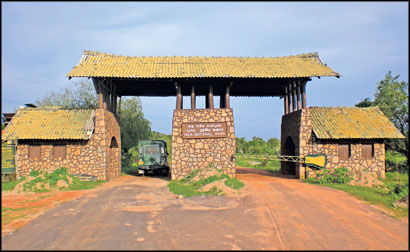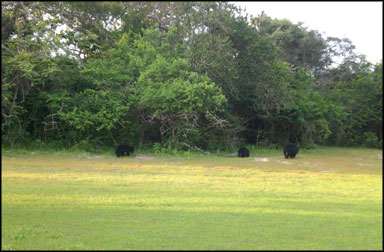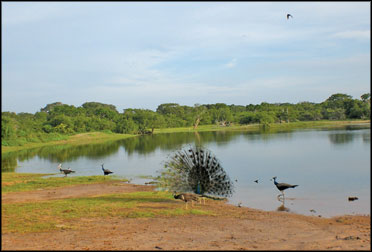
Yala a life-giver
Text and pix by Ganga PRADEEPA in Yala
Among the main National Parks in Sri Lanka Yala is the most popular
wildlife safari park which is situated in the South-Eastern corner of
the island. The park is famous for its high density of leopards, perhaps
the highest in the world.
|

Peacock in its glory |
The Yala Group of National Reserves is one contiguous system of
Reserves "National Park Blocks 1, 2,3, 4 and 5 Yala National Park and a
strict National Reserve as well as the adjoining Kataragama, Katagamuwa
and Kudimbigala Sanctuaries.
Temperate
Yala National Park is geographically located in Sri Lanka at latitude
06°16' - 06°42' North and longitude 81°15' - 81°42' East.
Climate
Being located in one of the arid regions of Sri Lanka, the climate of
National Park is usually hot and dry. The area receives its annual
rainfall during the north east monsoon from November to January and
unpredictable inter-monsoonal rains in March, April and September.
February is a dry month, with the dry season proper commencing in June
and lasting until September and sometimes until mid October.
Location
|

The entrance of the Yala National Park |
The Park can be visited via the town of Tissamaharama in the
Hambantota District of the Southern Province. Park area is belonging to
two provinces namely South and Uva Provinces. The total area of the park
(which is of 5 blocks) is 97,881 ha but only Block I and Block II are
open for visitors.
Accommodation
There are eight Park bungalows all of which are within Yala Block I.
Accommodation is available for 8-10 people in each bungalow on the basis
of prior reservations with the Department of Wildlife Conservation.
Apart from resident visitors occupying the bungalows, a large number of
day visitors enter the Park.
Physical features
Most of the area is underlain by Vijayan rocks formed over 600
million years ago. They are made up of hornblende and granite gneisses.
Pleistocene and Holocene alluvial and Aeolian deposits cover the Vijayan
series near the Menik ganga and along most of the coastline.
|

Three bears |
According to former Warden, Yala National Park, Childers Jayawardhana,
"The breached and denuded earth bunds of several irrigation tanks are
still visible, together with natural water holes and tanks improved to
hold water. These sources of water are a link in the survival of the
wildlife found within the area".
Established
The park was initially established in 1938 only with block I and
other blocks were included later.
Forest area
Forest area is dominated by Palu (Manilkara hexandra), Weera (Drypetes
sepiaria), Malitthan (Salvadora persica), Ehala (Cassia fistula), Divul
(Limonia acidissima) and Kohomba (Azadirachta indica). Thorny scrub land
is dominated by Eraminia (Ziziphus.sp) and Andara (Dichrostachys cinerea).
Sonneratia, Acanthus, Rhizopora and Lumnitzera species dominate the
mangrove vegetation.
Animals
All the big game mammals of the country are found within the park.
Elephant, Leopard, sloth bear, Spotted Dear, Wild Boar. Apart from them
small mammals such as Black napped hare, Grey, Ruddy and Striped necked
mongoose, Grey Langur and porcupine are common small mammals. Sri Lanka
is known for the highest leopard density in the world and Yala, the most
eco-friendly, attracts more tourists than any other park for this
reason. Once you catch sight of a male leopard crossing the road at dusk
to stalk a Sambur deer, phantom-like behind a bush you know this is
real. The bird population is profuse, stunning and in November-January,
the fantail peacocks everywhere is unforgettable.
|

Deer roaming freely |
Birds
Park is also famous for its abundant bird life. Over140 species have
recorded so far within the park. Changeable Hawk Eagle, Crested serpent
Eagle, Malabar pied Hornbill, Jungle fowl, painted Stork, White Ibis and
Black necked Stork are commonly seen. The bird population is profuse,
stunning and in November-January, the fantail peacocks everywhere is
unforgettable.
How to get there
Yala National Park is 309 km south of Colombo on the southeast of the
island. You can reach yala from South coast via Tangalla and Hambantota
or via Udawalawe from Ratnapura, Haputale or via Bandarawela,
Tanamalwila from Nuwaraeliya. Yala is close to Udawalawe National Park.
Jeeps can often be hired from Independent Safari Jeep Association.
The guides are employed by the conservation and wildlife societies and
must accompany all visitors to the park.
Uniqueness
The uniqueness of the park is the sheer diversity of the habitat:
dense jungles suddenly gives way to lagoons and open plain areas and the
park has a simply beautiful sea front.
Best months to visit
The best months to visit the park are between January and May, when
the vegetation is at its most lush. The dry season, from June to
October, offers a different view of the scenery as the waterholes dry
and the land takes on a parched and dry appearance.
As a result of the stunning natural beauty and plentiful wildlife,
Yala gets quite busy during the peak months and you will likely share
your viewing time with many other jeeps.
Kulu Safaris
Kulu Safaris operate their luxury camping service in Yala, which is
undoubtedly the best way to experience the park.
You will be on a safari drive long before and after all the other
jeeps have left, giving you the massive park to yourself.
*****************
[Access to the park ]
Access to Block 1
Ruhuna Yala National Park Block 1 on the southeast coast of Sri Lanka
is the Island's most visited wildlife reserve of the island. Sri Lanka
having been ranked 21st among the large bio-diversity hot spots in the
world, eco-tourism in the island has pushed Ruhuna Yala Park to
forefront of numerous wildlife reserves of the island.
Access to the park (Block 1)
The park is easily accessible from the coastal highway Colombo -
Bentota - Unawatuna - Galle - Tissamaharama. The main gate is at
Palatupana, 20 km from Tissamaharama. The other gate is on the
Kataragama - Situlpahuwa road.
Terrain of the block 1 of park
The landscape of block 1 runs over a spectrum of terrain: dense
jungle, scrub jungle, riverine woodland, rock pools, streams, freshwater
lakes & a long coastline which curves around Sri Lanka's southeast
coast. Pristine natural beaches & high sand dunes of the coast and add a
novel dimension to the considerable wildlife nurtured by the range of
habitats.
Panaromic views from vantage points
The enormous rocky outcrops, a distinctive feature in the scrub land,
provide vantage points to enjoy the beautiful dry-zone landscape of the
park. Then again to the south are dunes close to the coast. Of all the
vantage points set up by rocky outcrops, Situlpahuwa monastic settlement
at Yala's northern end dish out the finest view.
Season for Elephants
The best time to see elephants is during the January to May dry
season, when they congregate around the park's lagoons.
Leopards
With over 35 leopards seen in Block 1, Yala West has probably one of
the world's densest leopard populations. Panthera pardus kotiya, is a
distinct subspecies of its Indian cousins, the largest in Asia. The best
time to see leopard is February to July, when the water level of the
park is low. Vepandeniya is considered a favourite spot. However we need
to be accompanied by a resident naturalist.
Mammals
Among the 32 species of mammals are Sambar deer, spotted deer, muse
deer, barking deer, wild boar, wild buffaloes, pangolins, porcupines,
stripe-necked & ruddy mongooses, rabbits, wild cats, jackals macaque,
languor monkeys, toque monkeys and many more...
Sloth bears
Sloth bears are occasionally spotted, particularly in June, when they
feed on local fruit.
Crocodiles
There are also plentiful crocodiles marsh as well as estuarine.
Bird life
There are about 130 species overall. These birds include white-winged
black terns, curlews, pintails, barbets, hoopers, Malabar pied
hornbills, orioles, Ceylon shamas and paradise flycatchers, though pea
and jungle fowl are the most frequently seen.
Aquatic birds
The expanses of wetlands attract serpent - eagle, eastern grey heron,
painted stork. White-fowl arrive each winter to augment the resident
population. Among the common aquatic birds are various storks, egrets,
pelicans, sandpipers, herons, ibises, kingfishers & the magnificent
Indian darter. With a little bit of luck, you may also spot the rare
black-necked stork near Buttawa on the coast. GP
*****************
History of Yala National Park
Early History
According to the book of "Yala National Park" by Fauna International
Trust The earliest epigraphy "Brahmi" inscriptions discovered in Sri
Lanka and in this region date back to the 2nd century B.C. Prior to this
the Indo-Aryan settlers from Northern India as represented, in the
legend of Vijaya, were well established and in full control of the area.
Edifices of the earliest Buddhist cave monastery type began to be
constructed wherever there was human habitation and in suitable rock
outcrops, of which there are many in the area. There are to this day
innumerable and very interesting remains of cave dwellings from the
pre-Christian era.
|

Peacock dance watched by pea hens |
This region was part of the Rohana (Ruhuna) Kingdom, having an
advanced civilization as evinced by remains of dagabas and ancient
artificial reservoirs (tanks), built by clever hydrological engineers,
to irrigate large extents of cultivable land.
After the 10th century, historical evidence draws attention to the
absence of inscriptions later than the 10th century A.D. Architectural
and sculptural remains of the medieval period are absent. It would
appear to be a justifiable inference that some sudden de-population of
the region occurred. The ancient chronicles supply no information
whatsoever and the jungle tide spread covering the past with a mantle of
secondary forest. These have matured to the climax stands seen in Yala
today.
The Modern Era
At the turn of the century Yala Block I was declared a Game
Sanctuary. A small area west of the Sanctuary was set aside in which
resident sportsman might shoot. The main force behind this decision was
the Game Protection Society founded in 1894 by the plantation owners,
executives of firms, sportsmen and amateur naturalists favouring the
conservation of wildlife. Records denote that the first Game Ranger of
the Sanctuary was H.H. Engelbrecht, an Afrikaaner and a Boer prisoner of
war who was not returned to South Africa on account of his refusal to
swear allegiance to the British monarchy. After his release Engelbrecht
came to the nearby coastal town of Hambantota. Being on his own on
foreign soil, he found life hard. The Government Agent of the district
however, took pity on Engelbrecht and made him the custodian of the Game
Sanctuary around 1908. With his experience of wildlife on the veldt, the
post suited him admirably. He administered the region fearlessly and
with courage, using his whip to punish any miscreants. Many are the
tales of his daring and prowess with the gun. However, his German
ancestry proved to be his undoing.
He was falsely accused during the First World War (1914-1918), of
supplying meat to a German warship, the "Emden", and was taken into
custody. After the war, he was released and once again returned to
Hambantota where he died in poverty. Long after his death, it was proved
that he was innocent of the accusation. GP |



